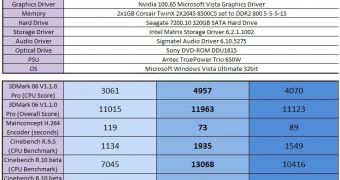Since Intel announced its new line of desktop and server processors based on the 45nm manufacturing process, everybody wanted to get their hands on one so that some actual results could be made available and from the numbers, conclusions could be taken down. Intel approved that some tests were necessary so that the general public would have something to gaze upon, hoping that one day they will also have that piece of technology.
Their preliminary tests included synthetic benchmarks done by comparison to the current top quad-core processor, and gave the world a little glimpse on what Penryn-based processors have to offer, performance wise. By using a pre-production Intel BadAxe2 Desktop Board D975XBX2 (Rev 505) on both a dual-core (3.33GHz, 6MB L2 cache, 1333MHz FSB) and a quad-core (3.33GHz, 12MB L2 cache, 1333MHz FSB) Penryn-based processors, Intel was kind enough to let some people come up with some figures for out viewing pleasure.
If you are wondering why the Penryn-based processors weren't tested on the current BadAxe2 motherboards, the answer is simple, the processors have a different power requirement than current Conroe-based models, they eat up less power and need a new Voltage Regulator Module (VRM). Current BadAxe2 models use a modified VRM so that the processor doesn't fry, due to the voltage difference.
Now, the series of tests that Intel performed on the Penryn processors at IDF included 3DMark06 V1.1.0 Pro, Mainconcept H.264 Encoder, CineBench R.9.5, Cinebench R10 beta, Half Life 2 Lost Coast Build 2707 and DivX 6.6 Alpha with Virtual Dub 1.7.1. The hardware platform also included graphics by ASUS in the form of the NVIDIA 8800GTX, 2x1GB Corsair TwinX 8500C5 running at DDR2-800 5-5-5-15, a Seagate 7200.10 320GB Serial ATA hard drive, a Sony DVD-ROM DDR1615, Antec TruePower Trio 650W PSU, and Microsoft Windows Vista Ultimate 32bit. The drivers used were Intel Chipset INF 8.1.1.1010, NVIDIA 100.65 Microsoft Vista Graphics Driver, Intel Matrix Storage Driver 6.2.1.1002 and Sigmatel Audio Driver 6.10.5275. The benchmark results are available on the picture seen at the beginning of the article.

 14 DAY TRIAL //
14 DAY TRIAL //